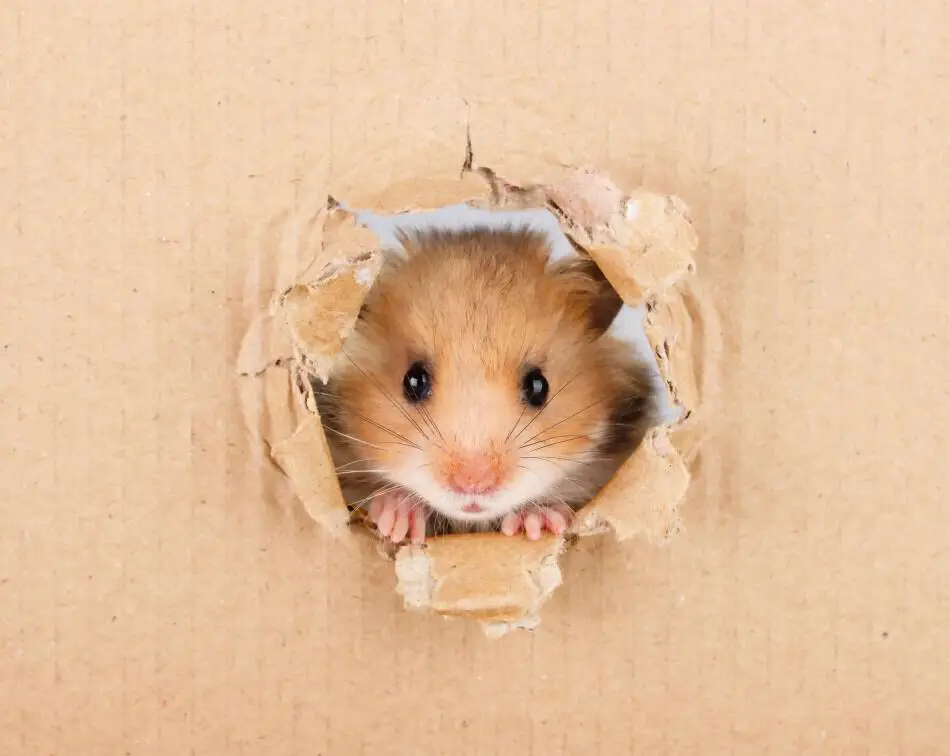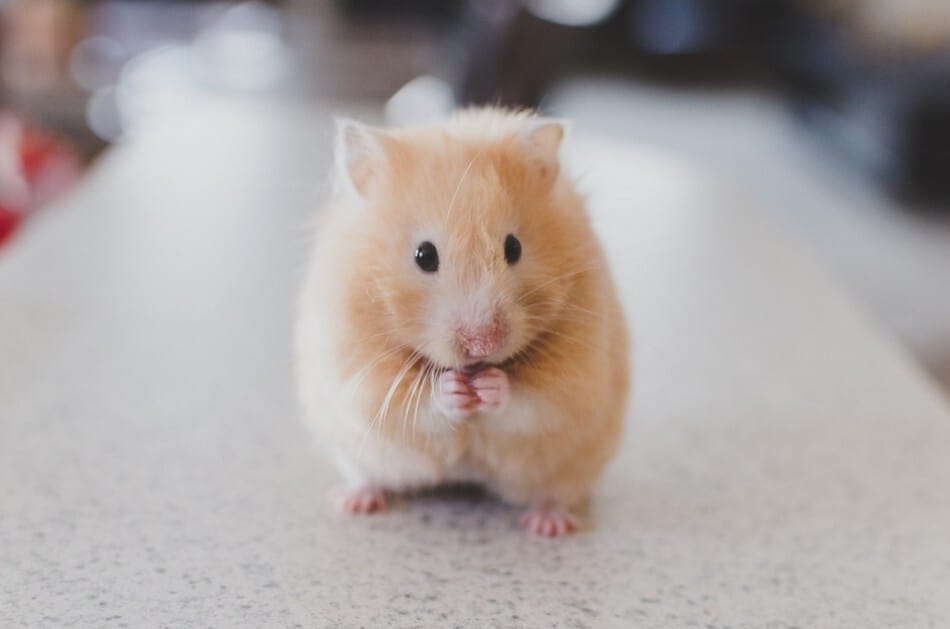Hamsters love affection from their human owners. In fact, it could even be said that they thrive on it, and hence require it.
After all, living in a cage must get pretty boring for your furry friend and what could be more exciting and fulfilling than time spent with you outside of it.
Be it running around in their exercise ball, or sniffing around in your lap, it is their chance to receive some attention, and also have some fun.
Why is my hamster biting me?
There are four main reasons why your hamster is biting you. If they feel threatened, if you startle them, if they don’t know you and often due to mistaken identity. Thankfully most can be avoided with a little care and attention.
Unfortunately, however, not all hamsters take to human interaction like a duck to water, and the result of this can be you receiving a bite.
A painful experience, and one that you certainly will not want to repeat.
This will, however, happen time and time again if you don’t take the correct action and look to understand why exactly your hamster is biting you all the time?
Table of Contents
Why Do Hamsters Bite?
There are four main reasons why a hamster may bite and these are:
- The hamster feels threatened
- They are startled
- That they don’t know you
- Mistaken identity
Feeling Threatened

In their natural habitat hamsters are the prey of a number of other animals. These include owls, weasels, storks, jackals, wild cats, snakes, and other predators that feed on ‘mouse’ like animals.
This means that they require some way of potentially protecting themselves, and the method they have chosen is to bite.
In captivity, of course, predation should not be an issue for your hamster unless you have another pet such as a cat.
However, your hamster does not know this or recognize instantly that you are not a predator, so its natural instinct is to bite.
Bite Avoiding Tip: Bond with your hamster. (More on bonding later)
Being Startled
Much like humans, hamsters can be startled by something unexpected. Unlike humans, however, who normally do little more than jump, hamsters tend to bite.
Examples of biting due to being startled include when they are approached from behind or are woken up from sleep.
Bite Avoiding Tip: Handle your hamster during the evening when they are most awake.
Stranger Danger
Hamsters do not tend to connect with multiple people like other animals do. Instead, they are happiest spending time with one or two owners.
They recognize owners by scent, rather than by sight and may be fearful of smells they do not know. Unknown smells may even be seen as threatening leading your hamster to bite.
Bite Avoiding Tip: Do not allow strangers (to your hamster) to handle them.
Mistaken Identity
As previously mentioned hamsters recognize owners by scent. This is due to them having bad eyesight and also applies to other things such as cage mates and food.
For this reason, it is therefore very easy for your hamster to mistakes your hand for a tasty treat. After all, to them, if it smells of food, it must be food, and therefore worth a bite.
Bite Avoiding Tip: Always wash your hands before handling your hamster.

How To Stop Your Hamster Biting
In the case of startled, stranger and mistaken identity biting the tips we have provided should suffice. However, this is only providing that you have bonded with your hamster ensuring that they know you are not a threat, but rather a friend.
Bonding with your hamster takes time and patience. It is a slow and gradual process that cannot be rushed. You should not be downhearted if it takes a month or longer to earn your hamsters trust, as a friendship between you will come.
Step One – Getting Used To Each Other
In the first week of having your hamster, you should simply sit by the cage when they are most active (evening) and talk to them.
You can sing, read, whatever you like if you are not sure what to say to them. Being by the cage allows your hamster not only to hear you clearly but also to get used to your scent. This, after all, is the main way they will recognize you.
At this point, you should not try to touch your hamster. If you need to pick them up for any reason, such as cage cleaning, do so by scooping them up in a towel.
Step Two – Getting Used To Your Hand
At this point, you should be continuing to sit by your hamster’s cage and talking to them. Now, however, you should also add placing your hand inside the cage.
Do this slowly and in increments so at first, you only have your hand on the cage door. Then, slowly each day after, put your hand in a little more.
This process should take around a week during which time you should not try to touch your hamster. You can, however, allow your hamster to touch and sniff at your hand during this time.
Step Three – Treat Time
In the last two weeks you may have discovered what some of your hamsters favourite foodstuffs are. If you haven’t try raisin, apple, or sunflower seeds. Offer whichever treat you have chosen from your bare hand, the one you have been putting in their cage.
Be aware that your hamster may not immediately take the food from your hand. This step in the process can take a few days so be patient, and most importantly, do not give up.
Step Four – Petting Your Hamster
By week four your hamster should be taking treats from your hand easily, and you can now move on to some gentle petting.
You should do this with your hamster still in the cage and without picking them up.
Petting is one of the stages that may take longer than most, picking up is the other, and should be given time.
If your hamster remains uncomfortable with petting try going back a step or two and building up again.
Step Five – Pick Up A Hamster
This step should only be tried once your hamster is very comfortable with accepting treats and being petted. You should go slowly with this step and let your hamster guide you how far to go each session.
In order to get them into your hands, it is a good idea to entice them onto your palm with treats.
Once there you can then bring your other hand into the cage under their belly, scooping them up with both hands.
Do not grip your hamster over his back, hamsters find this threatening. Also, do not hold them high off the ground in case they decide to jump.
What To Do If Your Hamster Bites
If you follow the tips and guidelines for stopping your hamster from biting you more than likely will be OK. However, there are no guarantees when it comes to this issue and you really should know what to do and what not to do just in case.
- DO NOT shake or hit a hamster that does not let go straight away after biting you.
- LOWER the hamster into its cage and gently prise it away from your hand.
- DO NOT shout at a hamster that has bitten you. This will scare it and increase the risk of it biting again in the future.
- CLEAN any wound with warm water and an anti-bacterial solution.
- DO NOT leave any wound uncovered. Use a loose piece of bandage or plaster to dress it.
- CHECK the wound in a day or two to make sure any swelling has gone down.
- DO NOT ignore any swelling that is still apparent. Seek medical advice instead as you may need antibiotics.
A happy and calm hamster won’t bite!
Ensuring your hamster is happy and lives a peaceful and fun life is all part of being a responsible pet owner.
No one wants to keep a hamster or any other pet for that matter confined to a boring dull hutch or cage. You need to provide a spacious home full of toys and interesting things for your hamster to play with.
We found this cage on Amazon which looks amazing and is the perfect home to keep your hamster entertained and happy.
A happy and calm hamster is less likely to bite you!
The cage featured here is an XL hamster cage full of runs, toys and exercise wheels to ensure your hamster is healthy and happy in your home.
Conclusion: Why is my hamster biting me?
Finally, and this is most important, you should not become afraid of your hamster after a bite.
Bites, after all, are a rarity in hamsters that have gone through the bonding process. Also, a handled hamster is a happy hamster and one that will thrive to the max.
Also consider if your hamster needs a partner or friend in the cage. Can hamsters live together? You can find out by reading our article on this very topic.












